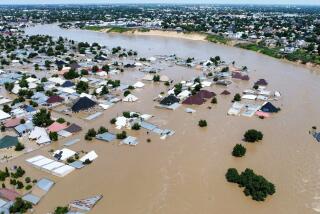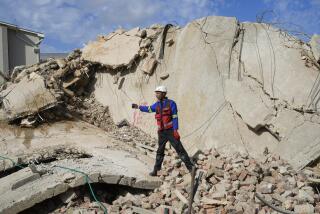Brazil dam collapse leaves 7 dead, up to 200 missing
Reporting from SAO PAULO, Brazil — Workers with Brazilian mining company Vale were eating lunch when a dam that held back waste collapsed, burying the restaurant and surrounding community in reddish-brown sludge, killing at least seven people and leaving up to 200 missing.
The status of the workers and others in the city of Brumadinho was unknown late Friday, hours after what President Jair Bolsonaro and other officials were describing as a “tragedy.”
Seven bodies had been recovered by late Friday, according to a statement from the governor’s office of Minas Gerais state. But the fear was that there would be many more as rescue and recovery teams dug through feet of mud.
Vale CEO Fabio Schvartsman said he did not know what caused the collapse. About 300 employees were working when it happened. About 100 had been accounted for, and rescue efforts were underway to determine what had happened to the others.
“The principal victims were our own workers,” Schvartsman told a news conference Friday evening, adding that the restaurant where many ate “was buried by the mud at lunchtime.”
After the dam collapsed in the afternoon, parts of Brumadinho were evacuated, and firefighters rescued people by helicopter and ground vehicles. Local television channel TV Record showed a helicopter hovering inches off the ground as it pulled people covered in mud out of the waste.
Photos showed rooftops poking above an extensive field of the mud, which also cut off roads. The flow of waste reached the nearby community of Vila Ferteco and a Vale administrative office, where employees were present.
“I’ve never seen anything like it,” Josiele Rosa Silva Tomas, president of Brumadinho resident’s association, told The Associated Press by phone Friday night. “It was horrible...the amount of mud that took over.”
Silva Tomas said she was awaiting news of her cousin, and many she knew were trying to get news of loved ones.
Another dam administered by Vale and Australian mining company BHP Billiton collapsed in 2015 in the city of Mariana in Minas Gerais state, resulting in 19 deaths and forcing hundreds from their homes.
Considered the worst environmental disaster in Brazilian history, it left 250,000 people without drinking water and killed thousands of fish. An estimated 60 million cubic meters of waste flooded rivers and eventually flowed into the Atlantic Ocean.
Schvartsman said what happened Friday was “a human tragedy much larger than the tragedy of Mariana, but probably the environmental damage will be less.”
The state fire department told The Associated Press that about 200 people were missing. The Minas Gerais governor’s office said 150 were missing.
Bolsonaro, who assumed office Jan. 1, said he lamented the accident and sent three cabinet ministers to the area.
“We will take all the possible steps to minimize the suffering of families and victims,” Bolsonaro said in a speech, which he posted on Twitter.
Bolsonaro planned to tour the area by helicopter on Saturday. The far-right leader campaigned on promises to jump-start Brazil’s economy, in part by deregulating mining and other industries.
Environmental groups and activists said the latest spill underscored a lack of regulation.
According to Vale’s website, the mine waste, often called tailings, is composed mostly of sand and is non-toxic. However, a UN report found that the waste from the 2015 disaster “contained high levels of toxic heavy metals.”
Vale is Brazil’s largest mining company. Two hours after the accident, its stock fell 10% on the New York Stock Exchange.
Just before midnight Saturday, firefighters put out a list of 187 people who had been rescued throughout the afternoon.
Of the 427 workers who were on hand when the dam collapsed, 279 had been accounted for, Vale said in a statement.
More than 100 firefighters were on the scene and 200 more were expected to arrive Saturday.
More to Read
Sign up for Essential California
The most important California stories and recommendations in your inbox every morning.
You may occasionally receive promotional content from the Los Angeles Times.









